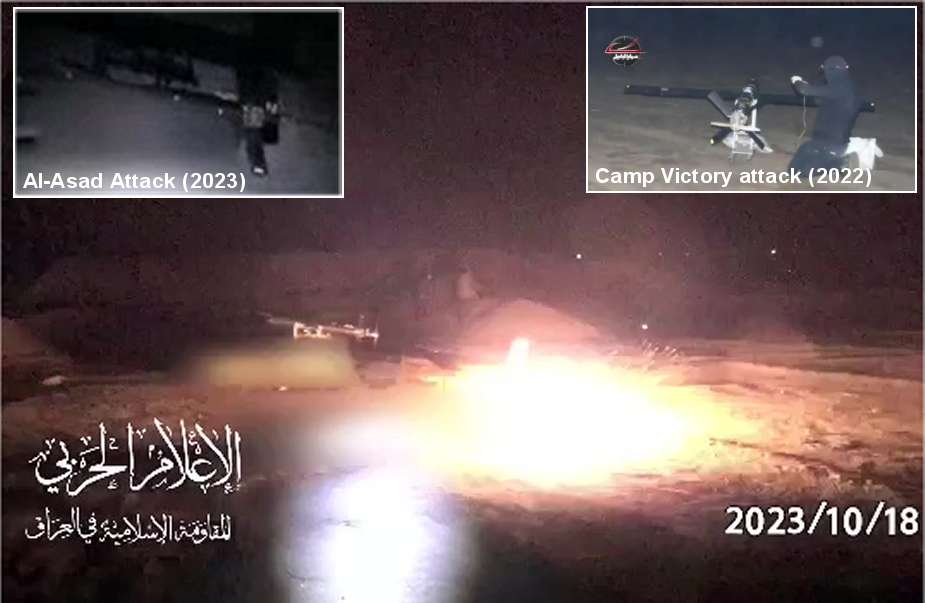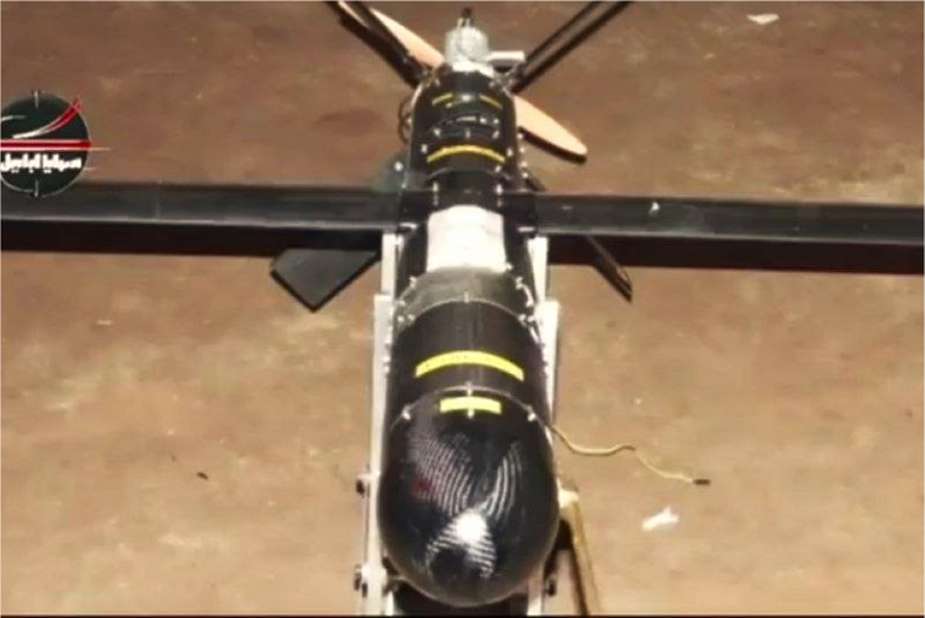Breaking news
Iranian-linked militias strike US bases in Iraq with Murad drones.
On October 18, 2023, according to Iran Defense, the two attacks on American military bases in Iraq were carried out by al Muqawama al Islamiyah fil al Iraq and Tashkil al-Waritheen militias, two Iranian-linked groups. In the first attack on Al-Asad Air Base, two Murad-5 drones were intercepted by coalition forces with no reported damage or casualties. The al Muqawama al Islamiyah fil al Iraq group claimed responsibility for this attack.
Follow Army Recognition on Google News at this link

The Murad-5 drones used against the American Al-Asad airbase in 2023 were already used against another US base in 2022 (Picture source: Twitter)
In the second attack on Harir Air Base, one drone was used, either a Murad-4 or an Ababil-2 according to Iran Defense's tweet, and it was claimed by Tashkil al-Waritheen, a group affiliated with the militia Harakat Hezbollah al-Nujaba and with direct links to Iran's Islamic Revolutionary Guard Corps-Qods Force (IRGC-QF). Later, the Islamic Resistance in Iraq also claimed responsibility for this attack.
The rest of the drone shown in the tweet makes it impossible to identify it, and there is no available information about the Murad-4. However, some information is available about the Murad-5 drone used against the Ain Al-Asad base.
The Murad-5 (also spelled as Morad-5) drone is a type of unmanned aerial vehicle (UAV) that was already employed in attacks against the American military base named Camp Victory located in Baghdad, Iraq, as proven by a video dated 2022.
According to Keyboard Basiji, the Murad-5 drone is described as potentially being of Iranian design. Its name was unveiled by Sabereen News, an Iraqi cross-muqawama (resistance) outlet with possible direct ties to Iran's Islamic Revolutionary Guard Corps-Qods Force (IRGC-QF), according to the Washington Institute.
The Murad-5's X-tail is not something usual in any Iranian drone, but an Iranian unnamed target drone shares a close design. It's possible they're related, as Iran has had both kamikaze and target versions of drones before, sometimes with design changes.
The design of the drone is likely intended to reduce its radar signature. The body appears to be constructed almost entirely of carbon fiber, and the drone has a wooden propeller. Carbon fiber materials can have radar-absorbing properties, which might make drones constructed from them less visible to radar systems.
For Keyboard Basiji, the estimated dimensions of the Murad-5 drone are as follows: a length of approximately 1.6 m, a wingspan of approximately 2.2 m, and a wing chord (width of the wing) of approximately 0.2 m. The Murad-5 is equipped with some form of Global navigation satellite system (GNSS) and a rocket motor for rocket-powered takeoff.
The attacks involving the Murad-4 and Murad-5 drones were orchestrated and carried out by Iranian-backed proxies in Iraq. The social media operations associated with these attacks suggested that Iran's Quds Force played a coordinating role. These attacks took place in the context of a broader situation where Iraqi militias had been increasing their involvement in the conflict involving Israel and Gaza. These militias had issued warnings regarding potential attacks on US targets in the region.

Picture showing the Murad-5 drone used against the American Camp Victory in 2022 (Picture source: Twitter)
There are strong indications that the recent actions and statements of the Iraqi militias were coordinated by Iran's Quds Force, which may have assigned specific roles to its proxies and allies in the region.
According to the Washington Institute for Near East Policy, Tashkil al-Waritheen, also known as Al-Warithuun, is a kinetic direct-action cell with ties to Iran's Islamic Revolutionary Guard Corps-Qods Force (IRGC-QF). It utilizes Iraqi operatives as a cover to conceal Iran's involvement in military operations conducted on or originating from Iraqi territory. This group was first publicly mentioned in a Combating Terrorism Center study in October 2020 and is believed to have been established by the IRGC-QF in October 2019. Its primary objective is to conduct paramilitary operations, often using drones, and to target entities that it perceives as being involved in the assassination of prominent leaders and those supporting policies that oppose Iran's interests.
Tashkil al-Waritheen has been involved in drone attacks on U.S. military facilities and other targets in the Middle East, such as Syria and Kuwait. The group's connections include affiliation with Iraqi militias like Harakat Hezbollah al-Nujaba, and it has been linked to cross-border attacks against Gulf states. Tashkil al-Waritheen has a social media presence on Telegram and appears to be associated with Iran's Qods Force and its network of proxy groups.
According to the same Institute, The Al-Muqawama Al-Islamiyah fil Al-Iraq, or the Islamic Resistance in Iraq, is not a distinct group but rather an umbrella term used to describe various Iran-backed militias operating in Iraq. These militias have been involved in drone attacks on U.S. bases in Iraq, and their actions suggest a coordinated effort with Iran's Quds Force. In October 2023, these resistance groups launched two drone attacks on U.S. forces stationed at Al-Asad Air Base in western Anbar and Harir Air Base in the Kurdistan Region.
The first attack at Al-Asad was not widely reported initially, but later, Sabereen News and other channels announced that the Islamic Resistance in Iraq claimed responsibility. The term "Islamic Resistance" is used to collectively describe Iran-backed militias in Iraq and indicates their alignment with Iran's objectives. In contrast, the attack on Harir was promptly reported and celebrated, with responsibility initially claimed by Tashkil al-Waritheen, a group affiliated with Harakat Hezbollah al-Nujaba and with links to Iran's IRGC-QF. It was later claimed by the Islamic Resistance in Iraq as well. The establishment of a new entity, the Operations Support Room for al-Aqsa Flood, on the same day suggests that these actions were part of a broader Iranian-orchestrated escalation in the region, where Iraq's resistance militias are preparing to support Hamas and Iran, possibly under the coordination of Iran's Qods Force. The use of Quranic verses and threats against the U.S. in the lead-up to these attacks further points to their organized nature and their alignment with Iran's regional agenda.
U.S. DoD responds to attacks and continues efforts to deter the spread of the Israel-Hamas war
DoD assets in the Red Sea, Iraq and Syria responded to missile and drone attacks over the past two days, as U.S. service members look to deter groups from using the Israel-Hamas war as an opportunity to launch conflict that could engulf the region, Pentagon Press Secretary Air Force Brig. Gen. Pat Ryder said on October 19. Ryder also spelled out the steps Secretary of Defense Lloyd J. Austin III has taken to strengthen DOD posture in the region to bolster regional deterrence efforts.
Ryder said the crew of the guided-missile destroyer USS Carney operating in the northern Red Sea earlier today shot down three land attack cruise missiles and several drones launched by Houthi forces in Yemen. "This action was a demonstration of the integrated air and missile defense architecture that we built in the Middle East and that we are prepared to utilize whenever necessary to protect our partners and our interests," he said.
There were no casualties
"We cannot say for certain what these missiles and drones were targeting, but they were launched heading north along the Red Sea potentially towards targets in Israel," the general said.
Ryder also detailed drone attacks on U.S. facilities in Syria and Iraq. The al-Tanf garrison in Syria was targeted by two drones on Oct. 18. "U.S. and coalition forces engaged one drone destroying it while the other drone impacted the base resulting in minor injuries to coalition forces," Ryder said. All of the injured returned to duty.
At the same time, early warning systems indicated a possible threat approaching the airbase at al-Assad. Base personnel sheltered in place as a protective measure. "Though no attack occurred, sadly, a U.S. civilian contractor suffered a cardiac episode while sheltering and passed away shortly thereafter," Ryder said.
Separately in northern Iraq, U.S. forces engaged and destroyed a drone resulting in no injuries or damage
Ryder said he will not detail what the American response to these provocations will be. "I will say that we will take all necessary actions to defend U.S. and coalition forces against any threat," he said. "Any response, should one occur, will come at a time in a manner of our choosing."
Ryder said U.S. forces deployed to the region are meant to deter any government or group from launching attacks under cover of the Israeli-Hamas war. The USS Gerald R. Ford Carrier Strike Group is in the eastern Mediterranean Sea and the USS Dwight D. Eisenhower Carrier Strike Group is crossing the Atlantic to join the Ford. The Air Force has also bumped up fighter presence to the region.
"By posturing these U.S. naval assets and advanced fighter aircraft in the region, we aim to send a strong message intended to deter a wider conflict, to bolster regional stability, and, of course, to make it clear that we will protect and defend our national security interests," Ryder said.
Secretary Austin is continuing engagements with counterparts in the region and beyond. Just today, the secretary spoke with officials in the United Arab Emirates, Qatar, Saudi Arabia and Israel. "During these calls, he reiterated U.S. support for Israel's right to defend itself from terrorist attacks, and also underscored the importance of safeguarding innocent civilians — both Palestinian and Israeli," Ryder said.
Finally, Ryder said that the systems the Israelis requested continue to flow into the country. These include precision-guided munitions, such as joint direct attack munitions, small-diameter bombs, 155-millimeter artillery ammunition and other categories of critical equipment. In addition, the United States is providing Iron Dome interceptors from stocks the United States has in Israel. In the days ahead, "we'll be flying additional Iron Dome interceptors so that Israel has the capabilities they need to sustain their defense systems and protect their citizens and from rocket attacks," Ryder said.



















